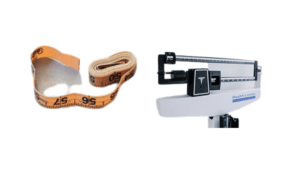Most people realize that losing weight isn’t easy. It is, however a simple process. To lose weight, you must burn more calories than you consume. There are a lot of different opinions and theories when it comes to how to lose weight, but one thing is for sure, you need to know how to take measurements for weight loss in order to know if you are either losing inches or pounds.
In fact, many people ask if they should measure and track their weight loss with a scale or with a tape measure. In this post we will explore this question as well as a few others and find out the answers that best suite YOUR needs. I am a firm believer in measuring your way to success. By measuring the results, you can certainly improve them.
Is it Better to Measure Pounds or Inches?
It is very difficult to choose one measurement over the other one since no two people will have the same weight loss journey. There are a variety of reasons for this such as genetic history, age, gender, body type and a host of others. Another very important factor that plays into this is motivation. For example, if we weigh ourselves each and every day after we exercise and see no results for our efforts, we can get discouraged and give up.

Another factor is that measuring your weight with a scale can be misleading because it only really tells you the actual weight loss and not the fat lost and/or muscles gained. In other words, weight includes all things that add to it. Bones, muscles, organs, food and, of course, water. Measuring just weight can certainly demotivate you.
So, what is the answer?
I believe the answer is to measure both pounds and inches. This way you can get an accurate indication of your exercise or diet routine. As mentioned before, losing weight may not be easy, but it is a simple process. Eat fewer calories than you burn. If you do this, then it simply becomes a matter of measuring and improving your results.
Change Your Mindset
One of the reasons losing weight isn’t easy, but it is a simple process is because of mindset. Often times it is a matter of changing one’s mindset. Sometimes we may need to change our way of thinking. For example, a scale is not always an indicator of success. You may not be losing weight, but you could be losing body fat in the form of inches and this is certainly a sign that you are moving in the right direction. When you see yourself moving in the right direction, you know your hard work is worth the effort. 
So, the mindset shift can go from “I am not loosing weight” to “I am losing inches, so I must be losing fat and gaining muscle”. Do you see how this mindset shift goes from a negative statement to a positive one?
How to Take Measurements For Losing Inches
Because muscle is more dense and actually weighs more than fat, it is important that we learn how to take body measurements to track our success because tracking the inches we lose is just as important as tracking our weight loss by stepping on a scale. So, how do we take measurements for losing inches?
Well there are five important measurement sites to consider and it is pretty straightforward to measure these areas. They are as follows:
Chest
Measure right under your breasts and up as high as possible using a weight loss measuring tape.
Hips
Measure around the widest part of the hip bones.
Waist
Place the tape measure around the area at a point half-way between the bottom of your ribs and the top of your hips. Then breathe out and take your measurement.
Thigh
Place the tape measure towards the top of the widest point of your leg and make sure you measure the same leg each time. Again, consistency is the key.
Arm
First of all, relax your arm and measure around the fullest part of the upper arm right above your elbow. Like the leg, measure the same arm each time.
How to Take Measurements For Losing Pounds
Besides the tape measure, the scale is probably the most important tool in your arsenal when it
comes to tracking your weight. If you want to lose weight, you’ll need
to track your calories consumed and burned.
You’ve heard it before, but it bears repeating: Tracking your food
intake and exercise is key to successful weight loss. That being said, some
experts recommend weighing yourself once per week, while others say
daily is enough.
How Often Should I Weigh Myself?
If you want to lose weight, you probably already know that weighing yourself regularly is important. But did you know that you shouldn’t weigh yourself every day?
The number of times you weigh yourself depends on whether you’re trying to lose weight. In general, you really should weight yourself about once a week or even every other week. If you weigh yourself too often you will not take into consideration normal fluid shifts. It is also important that you weigh yourself first thing in the morning and before breakfast. But, the important thing is that you are consistent in everything,
It’s easy to get discouraged if you see little change in your scale after weeks of tracking without any other lifestyle changes. So seeing what percentage of your body fat or what point you reached at a particular weight will keep you motivated. It’s also useful for gaining insight into your metabolism so you can determine how it’s responding to various foods. One thing you can consider is using a smart scale that measures BMI (body mass index).
BMI is the measure of body fat that is based on height and weight that applies to both men and women. It is also a very important measurement because, like measuring inches, it is another indicator that you are making progress in your weight loss goals. You can technically not lose weight, but improve your BMI showing good progress towards your goals.
Final Thoughts On How to Take Measurements For Weight Loss
As you can see, learning how to take measurements for weight loss is very important if you truly want to reach your health and fitness goals. As I mentioned many times, what you measure tends to improve over time. The more you understand what you are measuring, the more likely you will reach your goals and objectives. This is true in just about everything that depends on improvement.
So, rather than just focusing on measuring your weight in pounds, consider measuring your weight loss with measuring tape and track inches. You may also want to consider measuring your BMI by using a smart scale. Tracking results with technology has proven to help people track their results for better performance and reaching goals and objectives. For example, syncing your Fitbit to Weight Watchers in another way to track your health and fitness goals.
If there are other ways you have found success in tracking your fitness goals, feel free to leave a comment and share your ideas. Also, if you found value in the post, feel free to share it by clicking on the Pin button below.
